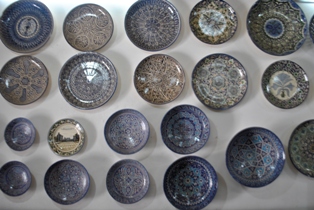Art and handicrafts of Uzbekistan
Art and handicrafts of Uzbekistan developed during dozens of centuries. Handicraft articles of Uzbekistan were substantial part of caravans of Great Silk Road passing through territory of modern Uzbekistan.
History of Uzbekistan brightened with the rapid development of art and crafts, coinage and the manufacture of jewelry, textile, gold embroidery, ornaments and painting on wood. Uzbekistan became a center for handcrafts having a great influence on national art of neighboring countries and regions.
Ceramics once played a huge role in the life of the people of Uzbekistan. Cups, bowls, vases and lots of other household objects, even toys were made of clay.
There are several pottery schools and it is believed that home town for ceramics in Uzbekistan is Rishtan. Pottery schools of Rishtan, Samarkand, Bukhara and Khiva differ from each other but in particular aspects they are similarities.
Present day ceramics masters are descendants of those craftsmen who decorated the mosques and madrasahs. Majolica décor is often used in the ornaments of ceramics articles of Khorezmian craftsmen.

In decors of Rishtan craftsmen azure, turquoise and white colors are used very often. Blue and white colors representing sky and water are believed to bring happiness.
If you are interested in ceramics of Uzbekistan, it is possible to visit workshop of the craftsmen. While your trip to the workshop of the craftsman we offer you make your own article from clay and take away by yourself.
The origin of embroidery dates back to ancient times. Once it was not craft but it was an obligatory skill that each oriental woman should posses. In the past women were made to be at home most of the time. So, spare time was devoted for embroidery.
Girls were taught to sew or embroider at early ages by their mothers or grandmothers. Before the marriage each girl had to embroider her own articles.
It can be suzannes, curtains, “dastarkhan”-tablecloth and others. Those who had unique patterns were adored by future mother in laws and it served as a motivation.

Embroideries were mainly used for decorating the interior of the house or design clothes. Suzanne served as decoration to be hanged on the wall. Patterns of Uzbekistan embroideries mostly resemble the imaginations of women.
Nowadays there are different schools of embroidery in Uzbekistan which are located in Samarkand, Bukhara, Khiva, Shakhrisabz, Boysun, Tashkent and Ferghana valley. Each school has its own trait.
Silk carpets are mostly handmade and only natural dyes are used while production. It takes about 2-3 months to complete one carpet depending on its measures and design.

Silk carpeting had been revived after establishing silk weaving factory in Samarkand.
Plants, insects and minerals are used to get the natural dyes. For instance Madder, pomegranates and indigo are used to get beige, red and dark blue colors.
During weaving of silk carpets both vertical and horizontal looms are used. Silk carpets are weaved by hand as well and it takes several months to complete.
The copper plate carving in the national art of Uzbekistan is represented by a rich variety of ornamental geometrical arabesque constructions built in flat-salient manner of carving.
Unusual technique of colored plates accounts a great number of carving approaches on double-colored or multicolored foundation.

Wood carving in Uzbekistan has a wide assortment of the products, from massive ceiling beams to tiny children talismans.
Development of this art is linked with the decoration of constructions and local architectural particularities.
In traditional architecture of the 19th-20th centuries, carved wood was sometimes the only decorative element of doors, gates, ceiling beams and pillars on covered terraces.
Jewelry manufacturing has always been important as it reflected public need for wealth and luxury. Among Jewelry schools of Uzbekistan Bukhara Jewelry schools is more developed than others.
Traditional Bukhara jewelry include head wear “Tilla Kosh” (the vault of the bride), temple pendants “mohitillo” (bibishak), and “kadjak”, chest jewelry “zebi-gardan” and “nozi-gardan”, earrings of a leaf type “barg”, “kundalsoz”, “khalka” and others, bracelets decorated with laced carvings in islimi style, belts for the aristocrats with big silver buckles and others.
In the 16th century the jewelers were granted with separate trading territory on central market, Toki Zargaron (the jewelers dome).
By Dilshod Eshmurodov





















